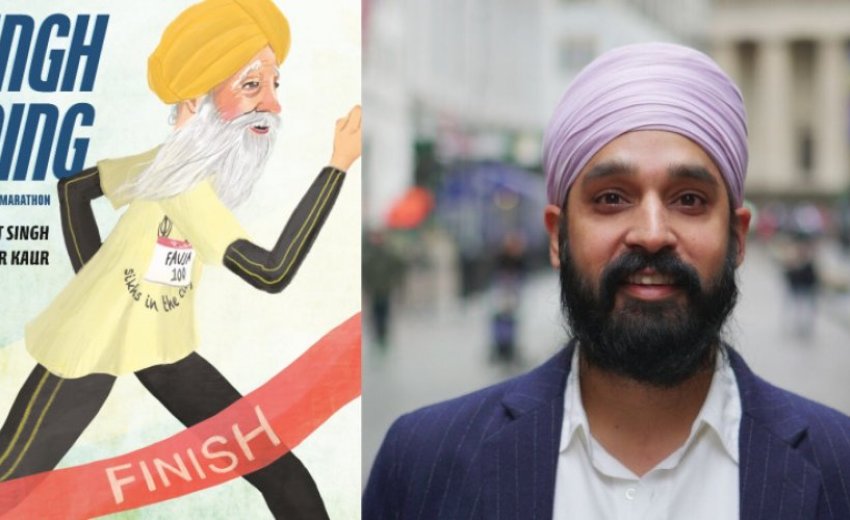When Simran Jeet Singh was a little boy growing up as a Sikh in South Texas, he yearned for books that featured characters who resembled him and his family in appearance. However, each trip to a bookstore or library resulted in nothing but disappointment. Three decades later, he returned to those shelves looking for books that mirrored the personalities of his young daughters but realized that nothing had changed.
In an email to CNN, Simran Jeet said that he wanted Sikhs to not feel invisible. He wanted them to take pride in their community and recognize that their tales deserve to be told.
Compiling the Sikh experience
Simran Jeet decided to write a children's book that was based on a Sikh character; something he had never read. So, he wrote the book ‘Fauja Singh Keeps Going’, published by Penguin Random House. The book is based on the true story of Fauja Singh, a British Sikh centenarian who ran a marathon in 2011 and is thought to be the oldest person to have completed such a race.
It is the first children's picture book by a major publisher to revolve around a Sikh story. Additionally, it was developed by an all-South Asian team.
Simran Jeet says,
“Fauja Singh’s perseverance and resilience inspire me to this day, and they are exactly the values I want to instill in my kids. I also believe that this book can help cultivate empathy for children of all backgrounds: if our kids can learn to see the humanity in those who seem most different from them, they will see the humanity in everyone they meet.”
Fauja Singh Keeps Going: A tale of perseverance
The story begins in the early 1900s in a small town in Punjab, India, where Fauja Singh was born and nurtured. Baljinder Kaur, a UK-based artist, contributes colour graphics to help bring the story to life.
The book chronicles the difficulties Fauja Singh encountered as a youngster. It details everything from the birth defect that kept him from walking until the age of five, to how his disability prohibited him from obtaining an education to his persevering efforts to create his strength.
It is a beautiful account of Fauja Singh's life from his childhood in India to his 80s when he decides to go to England to be closer to his family. The book transports readers to the moment Fauja Singh chose to take up running in his 80s, and how he overcame adversity to become the world-renowned marathon runner he is today.
It may appear strange at first that a narrative focusing on children features a man who is now 109 years old. He stopped running marathons in 2013. But Simran Jeet Singh said that one of the most important lessons he wanted to teach young readers was to be able to see the humanity in everyone, even those who don't look like them.
He says that part of what makes Fauja Singh's life so extraordinary is that it challenges so many of our preconceived notions. The book's foreword, which was reportedly written before Fauja Singh's most recent birthday, refers to the age difference between the author and the book's target readership.
The message from Fauja Singh reads, “I’m now 108 years old, which means I’m probably more than 100 years older than you. Can you believe that?”
Simran Jeet Singh said that Fauja Singh helped shape the plot even though he does not know how to read and cannot speak English. Through Harmander Singh, the centenarian's running coach, Singh and his team were able to connect with him. Harmander Singh would translate text into Punjabi for the centenarian.
Fauja Singh provides some of his techniques for living longer in the book's brief prologue and advises readers to never give up.
Fauja Singh says in the book, “I have really enjoyed my long life and hope you have a long and happy life too. I’d love for you to take care of yourself, try your hardest, and always choose yes when you meet a challenge.”
Singh wants to see more publications like this one published
"Fauja Singh Keeps Going" is full of pictures of everyday Sikh life, like a parent or grandparent combing a child's long hair (a sign of the Sikh faith), a visit to a Gurdwara (a Sikh temple), or a family eating roti and daal at the dinner table (flatbread and lentils).
Kaur, the book’s illustrator, wrote in an email to CNN, saying that like Fauja Singh, the story definitely resonated with some of her own experiences growing up in the diaspora. It is important to be able to tell these tales because it helps to develop bridges of understanding.
For young Sikh and South Asian children, normalising those pictures on the page can have a strong impact, according to Singh. He claimed to have previously witnessed it firsthand.
Simran Jeet Singh said, “When I first showed my four-year-old the book, I turned to the page where Fauja is doing his young daughter’s hair, and my daughter squealed with delight: ‘Look! That’s you and me every morning!’”
He further said that it made his heart melt. That was exactly what he had been hoping for all along. To have her daughter perceive Sikhs positively in a society where we are continuously portrayed as enemies meant everything to him. He further said,
“While I’m excited that this is a ground-breaking book in terms of representation, I also hope that we can eventually get to a place where a book with diverse characters is so normal that it doesn’t even register as something extraordinary,”
As significant as it is for Sikh children to finally have a book with characters who resemble their communities, Simran Jeet Singh expressed his hope that books like these will ultimately become the norm.
*Based on an article by Harmeet Kaur, published in CNN on 25th August 2020

